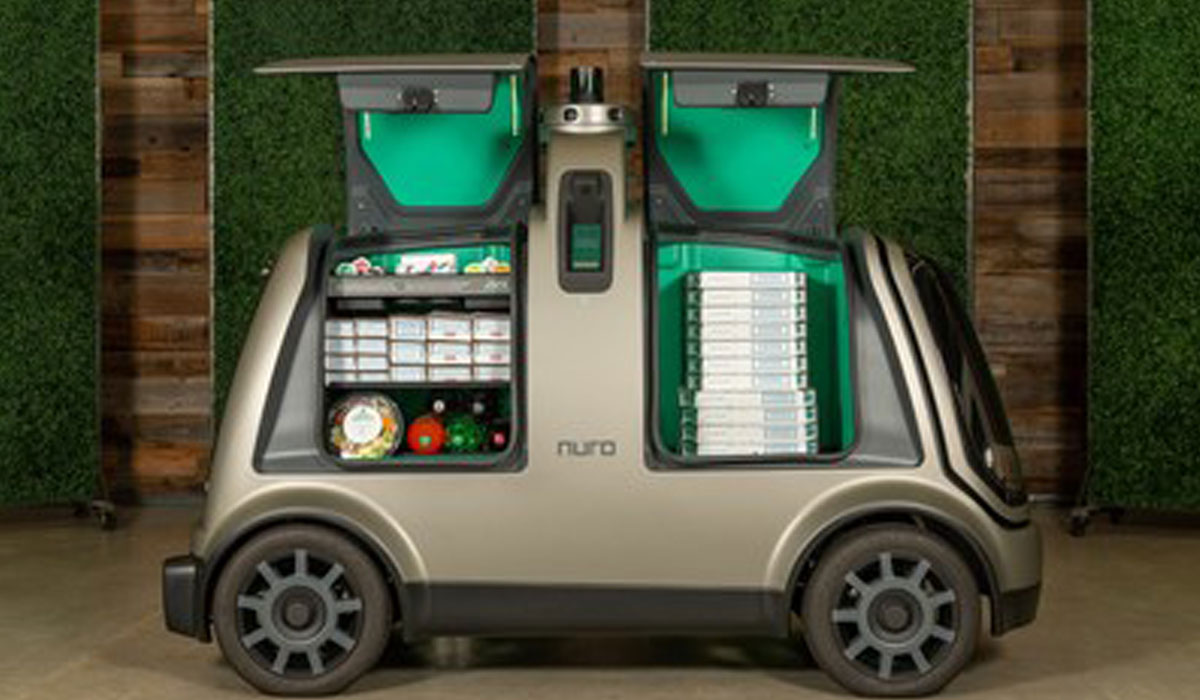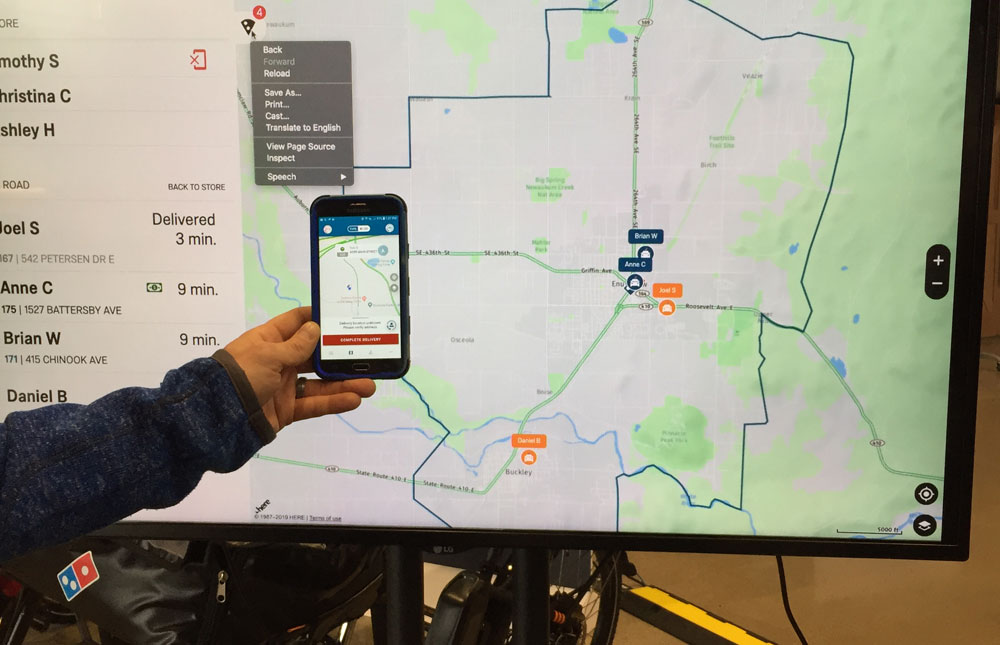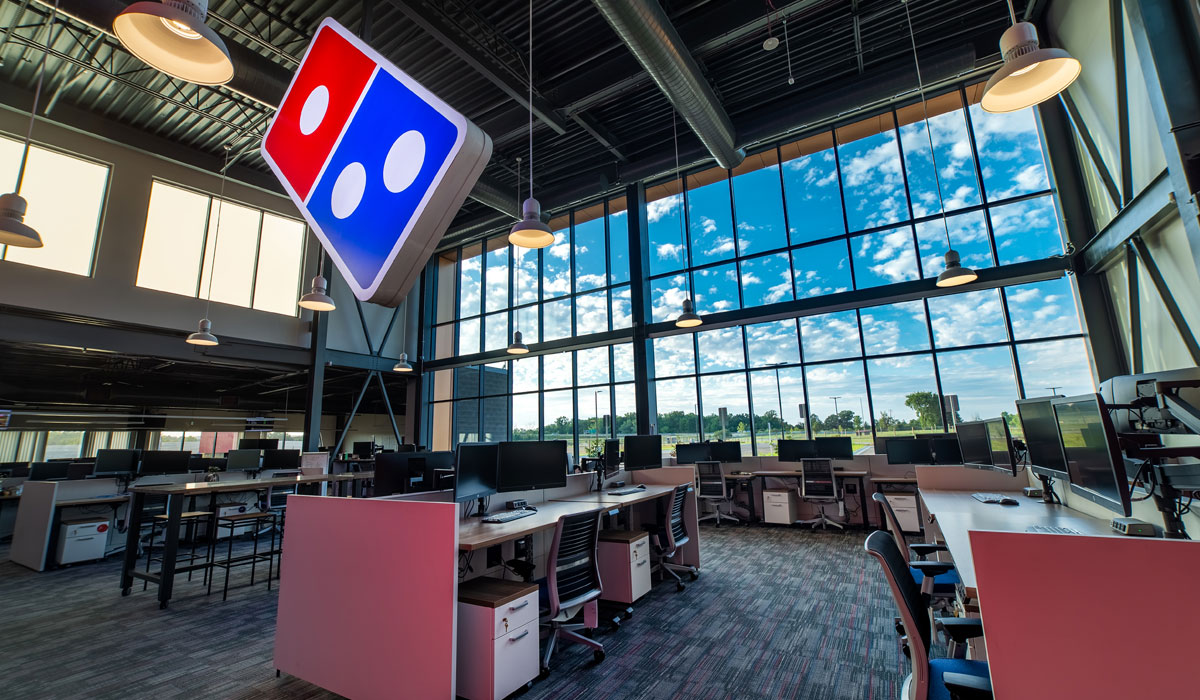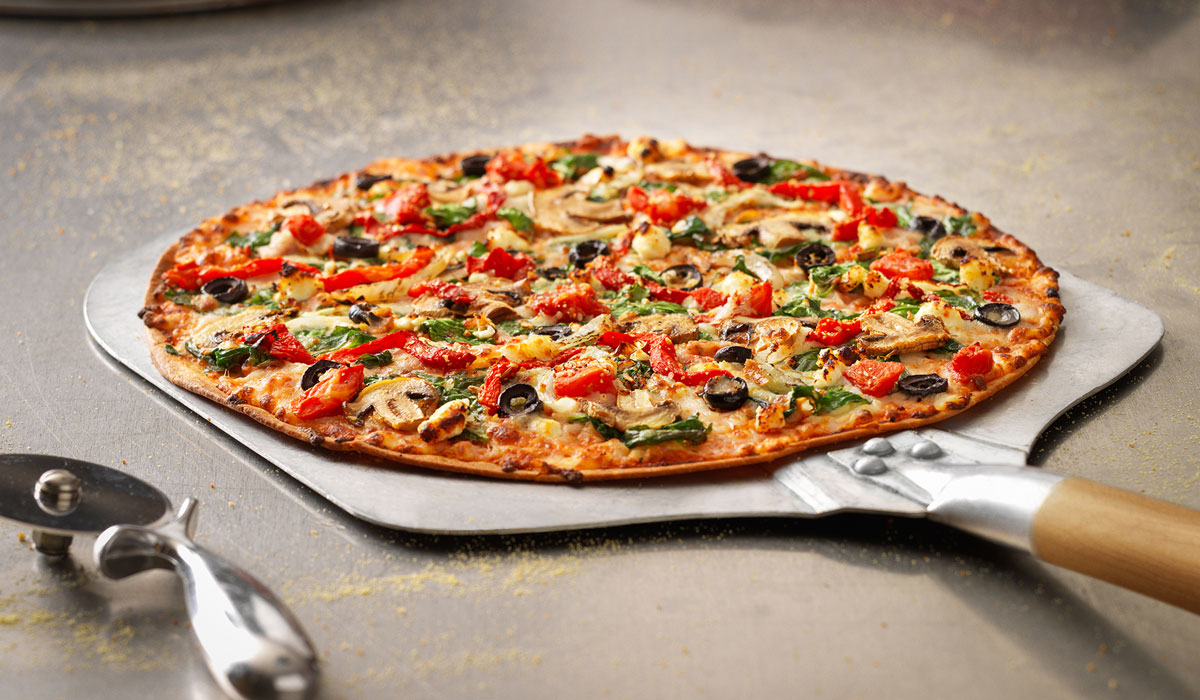Domino’s Pizza runs on delivery drivers.
It makes sense, then, that the brand is looking for ways to refresh the necessary-yet-expensive reality of human drivers, most recently with the upcoming test run of a custom-built robot car in Houston.
“This is the future of our company—this fundamentally changes our business model. The cost will be way different than what it is for delivery drivers. We struggle to find enough drivers. Minimum wage is going up. All of that changes with an autonomous vehicle,” chief digital officer Dennis Maloney said at a media event in Ann Arbor, Michigan, on Tuesday.
As more drivers switch over to jobs with booming third-party delivery companies like Uber Eats, DoorDash, and Grubhub, chains with strictly in-house service like Domino’s are left in the hiring lurch. Add in constantly-rising labor costs and filling open delivery positions becomes even more of a challenge.
READ MORE: Domino’s CEO says ‘shakeout’ coming to the delivery industry
The first Domino’s delivery robot will begin operating out of a single Houston unit before the end of 2019, offering a potential unmanned solution to the human driver hiring crisis. The vehicle was made by Nuro, a California-based robotics company founded by two former Google employees, and features a small-footprint design created specifically for hauling pizza and other Domino’s products.
The robot runs on electric power and is designed to make deliveries all day with no recharge. Customers are notified when the bot arrives at their address, then type in an access code to open one of the two product compartments and grab their food. The vehicle replaces the average car weight of thousands of pounds with a light, 25 mph, pizza-specific machine roughly the size of a golf cart.
Maloney said franchisees are ready to bring the automatons into their units, citing high driver turnover as a major stressor for operators.
“It’s really hard to get enough delivery drivers. They turn over more than anyone else and it’s probably the hardest part of the job. Being able to take some of that volume and have it done by an autonomous vehicle is something the franchisees really appreciate. [They’re] excited about it. It’s the future and it’s coming really fast,” Maloney said.

Working on the customer-robot experience is a different story. Domino’s CEO Ritch Allison said that one of the top areas of exploration for the Houston testing is the customer interface—how consumers are looking to interact with a robot on the curb or even in their driveway.
It’s not the first time the chain has experimented with self-driving pizza vehicles, though, and a previous four rounds of automated vehicle (AV) testing with Ford Motor Company generated a bevy of customer response. Allison said that, although the testing is no longer underway, the Ford partnership brought with it some valuable customer insights that Domino’s is drawing on now.
“Customers were really receptive to an AV delivery, and for a couple of reasons. Some don’t want to feel like they have to tip, and it does save a little money … Some would prefer to come out and not have a human interaction, just get their pizza and walk back inside,” he said.
The brand’s newly constructed Domino’s Innovation Garage (called the DIG around corporate headquarters) is the site for much of the Nuro testing. The DIG features a fully movable store model and various garage spaces for vehicles, allowing staff to simulate placing an order via one of Domino’s Anyware mobile platforms, sending orders to a store, and transmitting orders to unmanned vehicles.
While Allison said that there’s still much to learn both about the robot-delivery equation, he is looking ahead at a full incorporation of driverless delivery vehicles into Domino’s distribution model sometime in the not-so-far future.
“We’ll continue to test and learn but there will be a point in time when we … will be delivering product via autonomous vehicles of one type or another,” he said. He said the quick-serve is also testing out robots in its supply chain operations.

Better delivery tech
Domino’s is also looking for some other tech-savvy—albeit less futuristic—methods of upping delivery efficiency, including the rollout of a new tracking software that connects all those involved in a pizza order: customers, drivers, and operators.
The new GPS system is in place in a combination of 400 corporate and franchised stores across the U.S. after an Arizona test run, and is now available for operators to purchase at an undisclosed cost. The system not only allows customers to track their order as they would an Uber or Lyft, but also displays driver locations on large screens throughout Domino’s units so that operators can more efficiently schedule deliveries.
[float_image image=”https://www.qsrmagazine.com/wp-content/uploads/2019/10/Ritch.jpg” width=”50″ link=”” caption=”Domino’s CEO Ritch Allison continues to rail against the third-party delivery model.” alt=”” align=”left” /]
“[Customers can] track their food delivery driver right now. Aggregators have that capability and we’re rolling that out. But the cool thing that we have is … this actually shows you as a manager or team member inside the store where your drivers are, and it gives you information so you … can make decisions to get them back on the road quicker. If you know where people are and when they’re approaching, you can be ready,” director of delivery Mike Grange said.
At the core of the software is a driver app that tracks location and provides a call button for the driver to contact the customer with updates. With the system, customers can also call a driver directly for the status of their order instead of calling the store.
The software was created in-house by the Domino’s team (fittingly, a hefty majority—around 600 out of 1,000—of corporate employees fall into the IT department).
Grange said that the team’s major updates to the system are completed, but that the team is continuing to tinker with the user interface.
The company is also focusing on quickening orders not delivered by car. After debuting new Domino’s e-bikes in August, the chain is offering franchisees the chance to purchase the bikes.
Inspired by a Seattle franchisee who ordered a set of e-bikes to help his delivery cyclists make it up the city’s frequent hills, the Rad Power Bikes-created wheels speed up bike deliveries and also widen the applicant pool for delivery bikers who might not have a driver’s license.
Frictionless ordering
Domino’s began its foray into AI and voice ordering in 2014 when it unveiled “Dom,” AI tech born of a partnership with Google that allowed customers to voice order pizza. At the time, Dom was the only foodservice brand-run voice ordering platform in existence, putting Domino’s in the ring with top names in tech Apple, Google, and Microsoft, which were the only others offering voicer ordering platforms.
“We thought the most frictionless way to actually order pizza is the way that people were doing it long ago, the only problem is that they didn’t want to do it with a human anymore,” chief technology officer Kelly Garcia said. “We still think, ultimately, where this ends up is there will be a lot more consumers ordering though what is essentially your new speaker phone in your home—your Alexa, you Google Home.”
Now, the company is taking Dom into individual units by testing its ability to take phone orders in 40 stores. Garcia said that the conversational AI version is a third iteration of Dom, and that the full integration of the tech will depend on customer readiness.
“[This will be storewide] when customers are ready to adopt it. There is a lot of learning going on,” he said. “We do a lot of consumer research. We find out what our customers think and we’ll let our customers lead the way.”
![]()
Dom is only part of the brand’s widely accessible roster of ordering platforms. In 2015, Domino’s launched Anyware, a suite of ways for customers to place digital orders that included tweet, text, and smartwatch. Anyware has been expanding ever since its debut, with the addition of features like emoji ordering and 2016’s Zero Click app, which allows customers to order pizza by simply opening the app.
Maloney said the most-used Anyware platforms are the headless ones that work with Dom, like Amazon’s Alexa, and that those platforms are receiving some added tweaks and updates. Right now, Maloney said the chain is working with both Google and Amazon on a way to secure voice orders, particularly in relation to credit card information.
“They’re really important parts of our business, both because they’re helping us understand the technology and they’re growing. The voice technology unto itself is literally only three or four years old. There are things you don’t even think about … How do you secure it from a credit card standpoint? Those types are questions are still being resolved now,” Maloney said.

Steering clear of third-party
The Domino’s team might be dividing their attention among various tech innovations, but one area of operations will stay consistent with the rest of its nearly 60-year history—the chain won’t bring in any third-party delivery companies to transport pizza from its 6,000-plus U.S. units.
With the addition of the DIG and a laundry list of innovations in the works, Domino’s is honing in on tech advancements rather than entering into the third-party marketplace. Allison said that the company is in a unique position for continued success with in-house delivery, with a base of 85 million active U.S. consumer households and more than 23 million active loyalty program members (members who have placed an order in the last six months).
“We’ve got a tremendous customer base and data set already. I just cannot imagine why we would want to give that a competitor. And let’s be very clear, these aggregators are ultimately competitors of the restaurant companies that they serve,” Allison said.
To continue to hold its own against third-party delivery, Allison said that Domino’s delivery practices must ensure that the correct food is delivered hot, fresh, and on time, and that the price of the service is a good value for the customer.
Preservation of the brand’s image is another concern keeping Domino’s from third-party delivery, Allison said. While robots might be in keeping with this image, delivery drivers from other companies are not. “We feel very strongly about the image and the customer service experience that we present to you at the door and that’s why we will never have third-party deliver our food for us,” Allison said.






